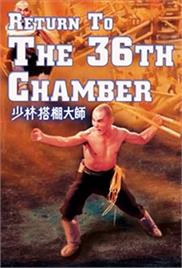Be Careful of Fake Websites. Always use HindiMovies.to domain & Join our Telegram Channel for Latest Updates.

Likes: 54
Views: 13.11K
The workers of a dye factory have their pay cut by 20% when the factory owner brings in some Manchu thugs to try and increase production. Desperate to reclaim their full wages, the workers hire an actor to impersonate a priest and kung-fu expert from the temple of Shaolin. The factory owner proves the actor a fraud, and punishes all those involved. The young actor feels he has let the workers down, and promises to atone. He sets out for Shaolin, determined to be accepted as a kung-fu pupil at the elite temple.
Duration: 99 min
Released: 1982
IMDb Rating: 7.1/10 (2,813 Votes)
Genre: Action
Stars: Chia-Hui Liu, Lung Wei Wang, Hou Hsiao, Lun Hua
Directors: ChiaLiang Liu
Writers: Kuang Ni
Year: 1982
Also Known As: Shao Lin da peng da shi
Return to the 36th Chamber is a classic martial arts action film from 1980 that masterfully continues the legacy of the highly influential "36th Chamber of Shaolin" series. Directed by Lau Kar-leung, also known as Liu Chia-liang, the movie represents a poignant blend of martial arts choreography, compelling storytelling, and cultural richness that has kept fans engrossed for decades.
The film is set in a turbulent era of Chinese history and revolves around the central theme of perseverance, knowledge, and mastery within the martial arts world. It deftly balances thrilling action sequences with an insightful narrative about growth and the pursuit of enlightenment through disciplined training and self-discovery.
Plot Synopsis:
"Return to the 36th Chamber" centers on the journey of Liu Yude (played by Gordon Liu), a character who departs from the traditional path of his Shaolin origins to become a teacher of martial arts in urban settings. Embarking on a mission to spread the teachings of Shaolin to the common people, Liu faces various challenges and adversaries along the way. Unlike the original "36th Chamber of Shaolin," where the focus was on the rigorous training within the temple, this film explores the protagonist's struggle outside the monastery walls, emphasizing how he adapts to new environments and obstacles while maintaining his connection to Shaolin traditions.
The storyline skillfully weaves action, drama, and moments of humor, showcasing not only physical battles but also the philosophical underpinnings of martial arts as a discipline and a way of life. As Liu Yude navigates his mission, the film delves into themes of social responsibility, innovation, and the transmission of wisdom across generations.
Main Cast and Characters:
Director and Writer:
Lau Kar-leung, a revered martial artist, master choreographer, and filmmaker, directed the film and was also deeply involved in its writing. His expertise ensures authenticity in the depiction of martial arts styles and practices, infusing the movie with a realistic and respectful portrayal of Shaolin culture. The script was designed to not only entertain but also provide insight into the philosophy and discipline behind the martial arts tradition.
Action and Cinematography:
The film is renowned for its exhilarating fight scenes, carefully choreographed to showcase the precision, grace, and power of Shaolin kung fu. The action sequences highlight a variety of martial arts techniques, combined with dynamic pacing and creative cinematography that elevates the viewer’s engagement. Lau Kar-leung's extensive background ensures that each fight scene serves the story and characters, rather than being mere spectacle.
Cultural Impact and Legacy:
"Return to the 36th Chamber" retains a special place in martial arts cinema, continuing the heritage of its predecessor and inspiring generations of filmmakers and enthusiasts. Its emphasis on training, discipline, and the dissemination of knowledge beyond the confines of Shaolin temple resonates universally. The film also contributes to the genre's international recognition during a golden era for Hong Kong martial arts movies.
While the movie primarily falls within the action genre, it subtly incorporates elements of drama and even social commentary, making it more than just a typical kung fu flick. Its themes of adaptation, education, and empowerment through martial arts remain relevant, underscoring the enduring appeal of Shaw Bros. productions.
Where to Watch:
For those interested in exploring this iconic entry in the martial arts film canon, "Return to the 36th Chamber" is accessible through various classic film distributors and may be available on streaming platforms specializing in martial arts or classic cinema.
In conclusion, "Return to the 36th Chamber" is a testament to the rich tradition of Hong Kong martial arts filmmaking. Its robust performances, meticulous direction by Lau Kar-leung, and thrilling action sequences provide a deeply engaging cinematic experience for fans of the genre and newcomers alike.